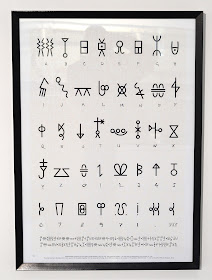 |
| Walter Whall Battiss |
Walter
Battis had no pretensions to be a wizard although he didn’t believe anything
was impossible. But his picture reminded me so much of Gandalf in certain
illustrations for The Lord of the Rings that I couldn’t resist that title. If
he was not a wizard, then what was he?
An artist certainly. Some critics put him in the upper league of
impressionists; he was certainly part of the New Group in South Africa who
turned away from the conservative styles. Later he became a friend of Pablo Picasso and Picasso's influence on some of his work is very strong. He was also a world traveler specializing in the islands
he loved. He was a quirky linguist who invented a new language for an island
(also invented) and convinced people to appreciate it, and he invented a new alphabet in a kind of
hieroglyphic script to write it in. From a conservative town and conservative
background, he treated the apartheid government of the day with contempt and
did what he liked. He was bisexual in an era where that was worse than one way or
the other, and he created some erotic art - pretty tame by today's standards - that led to his exhibitions being closed by the police. Indeed, he rejected every kind of boundary - creative, academic, political, cultural, spiritual. Battiss himself said: “In conforming I am wasting a hell of a lot of time…this ritual of conforming often gives people a certain security…And I like living in insecurity.” Warren Siebrits, curator of the Wits Art Museum (WAM) special exhibition in his honor, noted: “In the 1970s, Battiss made a T-shirt bearing a portrait of
himself with the slogan: ‘I Invented Myself.’ He did this time and again, from
his beginnings as a landscape painter in the 1920s to the inventor of Fook
Island in the 1970s, for which he is most fondly remembered.” You can read Siebrits' Sunday Times article here.
Speaking of the WAM exhibition, it's simply stunning. It's based on the hundreds of items - paintings, wood cuts, books, sketches - collected by Jack Ginsberg that he donated to the museum, and allows one to see all the periods and aspects of Battiss' work in one display. Most of the pictures below are courtesy of WAM, photographs Jonathan Everitt.
Battis was born
in Somerset East, a small Karoo town in the eastern Cape province to Methodist
parents in 1906. Always interested in drawing, he became fascinated by San rock
art when the family moved to a farm at Koffiefontein, an even smaller town.
Although interested in archaeology, his love of rock art was based on the aesthetic appeal it held for him, and he
used the style in a variety of ways in his own work. Picasso had a fabulous
collection of so-called ‘primitive art’ and claimed that he'd learned much
from it; Battiss was the same.
 |
| Battiss' take on San rock art |
Battiss studied law and then worked as a magistrate’s clerk while studying art and pursuing his interest in
the San people, even living with a San group for some time. He wrote several books about them and their art.
 |
| One of the 'orgy' pictures that caused all the trouble |
In 1965, feted with accolades and (unfairly) known as the ‘Bushman Painter’, he became professor of fine art at the University of South Africa and worked there until his retirement in 1971. After that he indulged his love of travel and especially islands. He was fascinated by the closed but relaxed nature of island life and a few years later he created a fictional island – Fook Island – complete with a map, history, plants, passports and language written in hieroglyphic-type symbols. He even created a driver’s license which he managed to get accepted in a few real countries! Yet far from being pure whimsy, he saw Fook as at the heart of his philosophy and said it was “an island which exists inside everyone.”
He even had a small connection to Botswana: in 1980 he designed four delightful postage stamps for them illustrating local folk tales.
 |
| Not a Battiss. This was a gift to him from Picasso |













One of my favourite artists!
ReplyDeleteMichael, this is all completely new to me. Oh how I wish I could see the exhibit.
ReplyDeleteI can see why you--and so many others--admire his work. It's fascinating...and from his life style, I wouldn't be surprised if he'd made it to Mykonos.
ReplyDeleteThanks for the comments! He really was a remarkable person and a very interesting artist. I'll check about Mykonos...
ReplyDelete